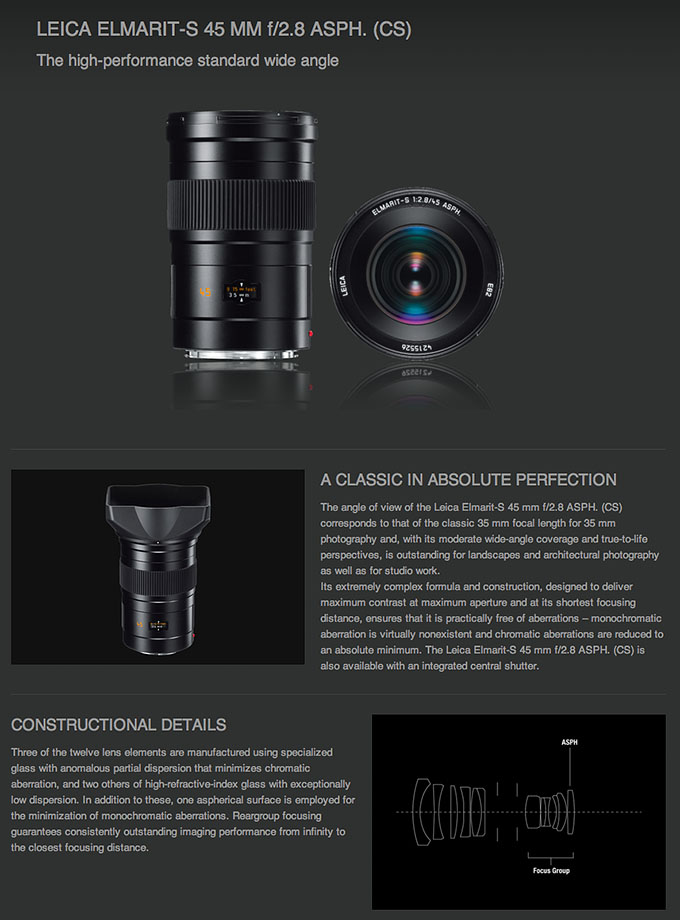NEW 45 f/2.8 wide-angle lens for the Leica S-System
So how many reading this own a Leica S system camera? If you are one of the lucky few then a new lens is on the way from Leica. A 45 f/2.8 which will give you a 35mm equivalent in full frame 35mm specs. This lens will be killer…expensive! Coming it at around $7500 it is yet another offering from Leica bordering on the absurd. If you have a fat wallet, or are a pro who makes the big time cash, then this will be a consideration. No question..the Leica S is a sweet piece of gear and this lens will surely be rock solid beautiful.
Anyone interested in this guy contact any of my highly recommended Leica dealers: Ken Hansen (khpny19@aol.com), The Pro Shop for Photograohers or PopFlash.com
So does anyone here own an S camera? If so, how do you like it? Do yo use it for professional paid work or just for pleasure?




Aberrations is the name for wave-front errors in how the lens delivers light to image plane. Parker is correct about chromatic and monochromatic aberrations, The monochromatic aberrations are describe with so-called Zernike polynomials. Any wave-front error map can be described as a superposition of the wave-front errors of the individual Zernikes. See this link for a visual representation: http://en.wikipedia.org/wiki/File:Zernike_polynomials2.png. Z1/-1 describes up-down and Z1/1 left-right focus differences. A lens with lots of Z4/4 will exhibit back focus in the corners and front focus in the up/down/left/right edges. Etceteras. Hope this helps. Pretty technical stuff.
Excellent information. As an engineer (in a different discipline), I can appreciate it. Thanks.
I’ve never heard of monochromatic aberration. I wonder if that is a new name for spherical aberration? Anyone know?
I wonder if they are talking about luminous noise. i.e. in the shadow, if you see red and blue dots, you know they are noise. If you see black, but it has grains or something like that, then it’s called luminous noise. I think I read about this at Luminous Landscapes.
Sorry, I gave you a wrong answer. Here is the right one.
Aberrations fall into two classes: monochromatic and chromatic. Monochromatic aberrations are caused by the geometry of the lens and occur both when light is reflected and when it is refracted. They appear even when using monochromatic light, hence the name.
Chromatic aberrations are caused by dispersion, the variation of a lens’s refractive index with wavelength. They do not appear when monochromatic light is used.
http://en.wikipedia.org/wiki/Aberration_in_optical_systems
I had hoped for a somewhat smaller size of this lens.
Regarding your question Steve:
I do own a S, I use it just for personal/amateur things, I like it a lot.
The viewfinder is a dream, the simple user interface is much to my taste, the AF is very accurate, and the IQ – in my view – is clearly better than everything else I own and use. Of course there are some limitations regarding available light and its not really a compact camera.
Regards,Tom
I live very close to the Pro Shop in West Palm Beach and have spent way too much money there. I fondled a “S” there shortly after it came to market. I have lusted for one ever since. The viewfinder is ridiculously bright and it is superb in the hand. While, yes, the $7,500 price causes pause, I am still trying to figure who this lens is aimed at. It is just a little wide, not really wide, so I don’t think it will be great for interiors or landscape. What say you?
Not being able to afford anything with the Leica name on it, I opted for the Pentax 645D. I’m a happy camper.
Being able to afford something with the Leica name on it, I opted for the Monochrom. I’m a happy camper. 🙂
Get a D800E. Problem solved.
Which problem?
Money. Size. Weight.
In these regards an OMD wins 😉
Of course; so does an iPhone. 😉
D800E is not much better than an iPhone 5s; and worse, it does not even have a dial tone!
well, S2 isn’t much bigger than D800 😉
That’s 3 questions…!!! As for the response, only one is correct – money…!!
Uh oh.
(just when I was settled with all my new gear)
Hi Steve, In a few years there may not be a need for such high quality glass. It seems possible that a superior lens can be simulated with software. Do you think that this process could match the quality of Leica glass? I know there is a lot more to a camera than its glass. The look, feel and build quality are important, but with this technology we could have fine optics on a budget. I appreciate your viewpoint.
http://vimeo.com/61495125#
http://www.cs.ubc.ca/labs/imager/tr/2013/SimpleLensImaging/
Thanks
James
Anything is possibly and technology is pretty crazy. Every year it seems we see more and more things that we would have thought to be impossible just 10 years ago.